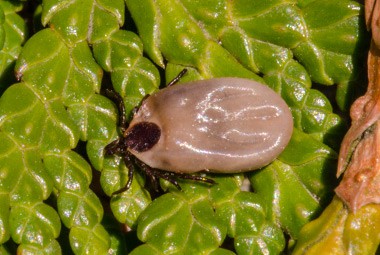
The American dog tick gets its name from its preference to feed off the domestic dog. American dog ticks are commonly found in the United States in areas east of the Rocky Mountains. Their populations are most concentrated in Massachusetts and down south to Florida. These ticks are also commonly referred to as wood ticks.
| Pest Identification | |
|---|---|
| Recognition | Adult American dog ticks are brownish in color with white or yellow markings. Females have marbled markings on the upper surface of the front part of their bodies, while males have the same marbled markings going across the entire upper surface of their body. Like other tick species the larvae of the American dog tick only has 6 legs. Adults have 8 legs and before feeding are about 3/16th of an inch in length and have an oval flat looking body. After feeding this tick will become engorged and can grow up to 5/8th of an inch in length. |
| Biology | American dog ticks are considered to be three host ticks because they feed on three different hosts throughout their development into larva, nymph, and adult. The life cycle of the American dog tick begins when the adult females detach themselves from their host and land on the ground, usually under some leaves or in heavy vegetation; she will then lay up to 5,000 eggs. The six-legged larvae will emerge from those eggs and find a small mammal like a mouse to attach themselves to and feed on. The larvae will then drop off and cast-off their skin to become an eight-legged nymph. The nymph then goes on to find another small mammal to attach to and feed on. After a period of time, they will grow into an adult who will then look for a preferred large host to feed on such as: Dogs, Coyotes, Deer, Domestic cats, Livestock, & Humans. The entire process of developing from egg to adult can take anywhere from 3 months to 2 years depending on environmental conditions. When American dog ticks bite their hosts they can spread a variety of dangerous diseases including tularemia, a type of bacterial infection, which can lead to tick paralysis. They can also transmit Rocky Mountain spotted fever, and Colorado tick fever. When removing an attached American dog tick from you or your pet it is important to use tweezers or forceps instead of your fingers. Squeezing the body of the American dog tick can lead to its body fluids being released onto your fingers which can then be spread to your mouth, eyes or other mucous members causing the increased spread of Rocky Mountain spotted fever and other diseases. |
| Habits | American dog ticks are unable to fly. They lay in wait in areas where their host commonly passes through or spends time in. They can commonly be found in the grasses and vegetation found in parks, fields, along wooded paths, vacant lots, and alongside of roads. American dog ticks do not survive well indoors. If you find an American dog tick inside of your home it was most likely recently brought inside on you, your clothing, or your pets. |
| Prevention | Controlling the spread of ticks can be a difficult task, but can be achieved by altering the environment to make it less appealing to ticks and their hosts, by protecting yourself from ticks, and by implementing a professional tick control program. Personal Protection Use insect repellants that contain DEET when spending time outside, especially in wooded areas. Wear light colored, long sleeves and long pants that are tucked into boots while outside. Check yourself, children and pets before coming inside. Treat your pets under the guidance of a veterinarian with tick preventative. Keep grass cut very low, especially around fences, sheds, garages, and trees. Remove piles of leaves, sticks, and other organic debris that ticks can hide and live in. Keep hosts away from your property by making sure that garbage cans have tight-fitting lids on them, not feeding birds, and making necessary changes around your home (install chimney caps, attic vent screens) in order to prevent rodents and wild animals from being able to enter inside. Use insect repellants that contain DEET when spending time outside, especially in wooded areas. Wear light-colored, long sleeves and long pants that are tucked into boots while outside. Check yourself, children and pets before coming inside. Treat your pets under the guidance of a veterinarian with tick preventative. |
| Professional | A Rottler technician will inspect your property and treat the exterior perimeter of the structure or the entire property with an appropriately labeled residual pesticide if ticks are present. Rottler technicians may also perform an exterior perimeter rodent control program to reduce the host populations for this tick. |

